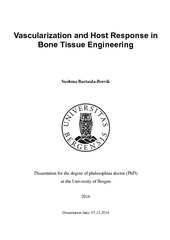Vascularization and Host Response in Bone Tissue Engineering
Doctoral thesis
Permanent lenke
http://hdl.handle.net/1956/15230Utgivelsesdato
2016-12-07Metadata
Vis full innførselSamlinger
Sammendrag
The major hurdle in the survival of a tissue-engineered construct after implantation is vascularization. Pre-vascularization is one of the proposed methods to achieve vascularization in tissue-engineered constructs. This thesis is centered on prevascularization of the tissue-engineered construct and local host response upon implantation in vivo. In Study I, mesenchymal stem cells (MSC) with and without endothelial cells (EC) were cultured in normoxic and hypoxic conditions in vitro. The conditioned medium from each group were evaluated with functional assays. The secretomes from hypoxic mono- and co-culture groups demonstrated increased wound healing and tube formation in vitro when compared with their normoxic counter-parts. In Study II, pre-vascularized constructs were generated by co-culturing MSC and EC in three dimensional copolymer poly (LLA-co-DXO) scaffolds. After in vivo implantation, local tissue response was evaluated with gene and protein analysis. The constructs with both MSC and EC were associated with decreased pro-inflammatory cytokines compared with those having MSC alone. In Study III, three-dimensional constructs with either MSC or EC alone were implanted and their angiogenic and immunogenic property were evaluated. The expressions of anti-inflammatory and vasculogenic cytokines were higher in the constructs with EC than in the constructs with MSC. Furthermore, down-regulation of pro-inflammatory cytokines was observed. In conclusion, MSC in combination with EC developed microvessels-like structures before implantation in vivo. Hypoxia, a common consequence after implantation of constructs, accelerated wound healing and tube formation via paracrine effect of MSC. Combining these two effects might lead to inosculation and survival of a graft. Addition of EC improved the immunomodulatory property of MSC.
Består av
Paper I: Bartaula-Brevik S, Bolstad AI, Mustafa K, Pedersen TO. Hypoxia preconditioning of mesenchymal stem cells accelerates wound healing and vessel formation in vitro. (Submitted manuscript). Not available in BORA.Paper II: Bartaula-Brevik S, Pedersen TO, Blois AL, Papadakou P, Finne-Wistrand A, Xue Y, Bolstad AI, Mustafa K. Leukocyte transmigration into tissue-engineered constructs is influenced by endothelial cells through Toll-like receptor signaling. Stem Cell Research and Therapy. 2014; 5(6):143. The article is available here: http://hdl.handle.net/1956/9407
Paper III: Bartaula-Brevik S, Pedersen TO, Finne-Wistrand A, Bolstad AI, Mustafa K. Angiogenic and immunomodulatory properties of endothelial and mesenchymal stem cells. Tissue Engineering Part A. 2016; 22(3-4):244-52. The article is available here: http://hdl.handle.net/1956/15250
